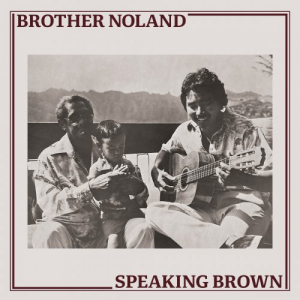Brother Noland - Speaking Brown '2024
24bit

| Artist | Brother Noland Related artists |
| Album name | Speaking Brown |
| Country | |
| Date | 2024 |
| Genre | world,pacific |
| Play time | 38 min |
| Format / Bitrate | 24 BIT Stereo 2429 Kbps / 96 kHz |
| Media | WEB |
| Size | 95; 225; 758 MB |
| Price | Download $6.95 |
Order this album and it will be available for purchase and further download within 12 hours
Pre-order album Tracks list
Tracks list
The year was 1980, and the influences of artists like The Sunday Manoa, Gabby Pahinui, Olomana, and Keola and Kapono Beamer resonated throughout the islands as they heralded a new sound of and for modern indigenous peoples, part of the cultural revolution known as the Hawaiian Renaissance. On the other side of 1970s island life, bands like Kalapana, Country Comfort, and Cecilio & Kapono were shaping a contemporary sonic identity for locals — indigenous and otherwise — blending rock, soul, country, and jazz into a pleasant pop blend that continues to inspire musicians today. In the middle of it all was Brother Noland. In a catalog that now spans more than 40 years, Speaking Brown is Brother Noland’s magnum opus. Listen to the album in full, and you’ll instinctively understand this as the songs unfold. The music — all originals, save for “HaleakalĆand “Manowaiopuna/KÅ‘ula†— melds Hawaiian music with contemporary styling, but not in the way that The Sunday Manoa or the Beamer Brothers had done in the previous decade. Close comparisons are Chucky Boy Chock’s folksy explorations of Hawaiian music on his Oahu Brand and Brown Co. Vol 1 albums, and Nohelani Cypriano’s 1979 debut LP, which married Hawaiian instruments with modern genres. Cypriano’s effort was much more pop-centric than Noland’s; her recordings nod to current and past eras (like Motown and hapa-haole), whereas with Speaking Brown each song is place-based or in tribute to a loved one, a typical quality of Hawaiian mele. The album grew from modern and ancestral Hawaiian identities, and from Aloha ‘Āina, the love and respect for Hawai‘i, its land and its people, which remains a core belief Brother Noland practices to this day. The album opens with an original arrangement of “HaleakalÄ Hulaâ€, composed by Alice NÄmakelua. The first 30 seconds of the song indicate how Brother Noland does things: the rocking rhythm and disco syndrum propel the layered guitars and vocal harmonies into a fusion of old Hawaiian music with modern day attitude. Sung in ‘Ōlelo Hawai‘i, as a listener you might think you know what to expect herein, but so far it’s unlike anything you’ve heard. This is the way Brother Noland does things: familiar, but different. The “hits†on Speaking Brown were limited to “Pua Laneâ€, which today remains a staple in Noland’s live performances, and “Pueo, Tara and Meâ€, which is currently part of Hawaiian Airlines’ in-flight music video programming. Both songs, coincidentally, represent Noland’s upbringing: in the urban projects of Palama Settlement in Honolulu, and among the rolling hills of Waimea on Hawai‘i Island. Another cut, “Look What They’ve Doneâ€, would’ve made an impact if not for local radio stations banning it, fearful of repercussions from broadcasting its criticism of development of Hawaii’s iconic (read: “profitableâ€) tourist destination, WaikÄ«kÄ«. But Noland wasn’t looking to make hits or political statements — he wanted to make an album. Noland recognized the need to have recordings of his own so that he could stand alongside his industry peers. By the time “Kawaihae†kicks in on the B-side, the album has gently woven itself into your heart and soul, its roots reaching to the soil, sky and sea, its vision looking to past, present and future. But you have to let this happen. There’s no hurry on Speaking Brown; you need to be present to understand its power. Like the gradual unfolding of a morning at HaleakalÄ, it’s not possible to look just at the sunrise — you inherently take in the mountain’s magnificent shadow, which stretches across the cloud layers, the small towns below, the majestic sea surrounding Maui, the infinite horizon. In a time of impossibly short attention spans, Speaking Brown might get overlooked. We hope that instead of celebrating this album simply for the cuts that eventually became Brother Noland's biggest hits, listeners can enjoy Speaking Brown for what it is: a whole greater than the sum of its parts; a cornerstone of Brother Noland’s life’s work; and one of the most innovative albums of modern day Hawai‘i, which has shaped contemporary island music in a way that’s familiar, but different. Tracklist: 1.01 - Brother Noland - HALEAKALà (3:11) 1.02 - Brother Noland - THE PUEO, TARA AND ME (4:47) 1.03 - Brother Noland - GOOD MORNING, HALE'IWA (2:22) 1.04 - Brother Noland - NU'UANU WALK (4:35) 1.05 - Brother Noland - MAN OF THE ISLAND (3:51) 1.06 - Brother Noland - KAWAIHAE (4:07) 1.07 - Brother Noland - MANOWAIOPUNA/KÅŒ'ULA (3:27) 1.08 - Brother Noland - PUA LANE (4:16) 1.09 - Brother Noland - LALANAPUNANI (3:53) 1.10 - Brother Noland - LOOK WHAT THEY'VE DONE (4:14)
